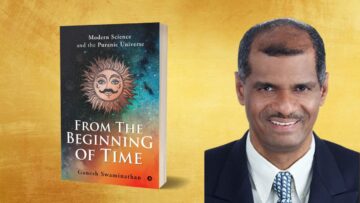Madhureima Devii Dasi adorns many hats. She is a researcher, a development professional, an inner worker, an astrologer, a writer, and a painter who believes all creative expression is “downloading from the source”.
Madhureima was born in Ghatsila, a picturesque mining town in Jharkhand (then Bihar). Waking up to copper red dawns, the blue Siddheshwar range, a variety of flowers and chirping birds, and the sound and breeze of Subarnarekha River, birthed the artist in her early in life. She grew up in a large family and lived a joyous childhood sharing strong social bonds with her neighbours.
It was here that Madhureima was piqued by Indian epics. She remembered her early childhood days when she was gifted a children’s Ramayana book with colourful illustrations. “I flipped through the book whenever I could and made every person I met, read it to me. In no time, the book was on the tip of my tongue my tongue tip and I became an amazement for all those who knew me.”
Watching Ramayana and Mahabharata in her neighbour’s house was a much-awaited event in her childhood. Fondly recalling, she told us “ I was so in love with Mahabharata that I once fell in an open drain while running to my neighbour’s house to watch it. In the 80s, there were no phones. To alarm me, my neighbours increased the TV volume when “yada yada hi dharmasya”, the title track of Mahabharata played.”
When she grew up a little more, Madhureima’s grandmother read Kashiram Das’ Mahabharata to her grandfather and her. The three spent time reflecting on it. This allowed Madhureima to speak her mind on the itihasas and analyse the characters and events of the epic. This encouragement that she received at an early age, continues to nourish her even today.
However, this idyllic life was truncated in 1989 when Madhureima moved to Hyderabad with her parents and sister. Life in Hyderabad presented a stark contrast from life in Ghatsila. Here social bonds were weaker and there was pressure to perform in school. Madhureima says she continues to grapple with the amount of trauma she experienced as a child and teenager due to the sudden changes in her environment. This piled up trauma broke her both physically and emotionally in her 20s.
Madhureima works with a social enterprise and spends her leisure hours painting, studying Jyotish, and reflecting on consciousness, the human mind and energy dynamics. She has written the short story on Madhavi in Aryaa: An Anthology of Vedic Women.
In this conversation, Madhureima shares her experience of writing the story of Madhavi for the ‘Aryaa anthology’ and her own journey that led her to calling herself Madhureima Devii Dasi, meaning the ‘Servant of the Goddess’. Her official name is Madhurima Malladeb.
What piqued your interest in writing about Madhavi?
In my short story on “Madhavi” in “Aryaa”, my protagonist wonders if she chose the legend of Madhavi or the story chose her. I feel the same.
Despite my interest in Mahabharata, I did not know the character of Madhavi till 2016. In September 2016, on my way to a spiritual retreat, I met an actor who had played the character of Madhavi on stage. As I didn’t know about the character, I googled about her. And what I found on the internet both intrigued me and left me with a feeling of unease.
In Mahabharata, we meet Madhavi in Galava’s story. It’s not her story. Galava’s story is told to Duryodhana by Devarishi Narada in the Udyog Parva of Mahabharata. Devarishi Narada narrates this story to persuade the Kuru prince to drop his vanity and obstinacy. Madhavi appears in this story as the saviour of two men, a young and adamant ascetic, Galava and her own father Raja Yayati who is infamous for his vanity.
I share a karmically complex relationship with my parents, especially my father. I have been struggling to forgive him to heal my physical and emotional body. At times, I have been so sick that it was impossible for me to stand on my feet. On the contrary, Madhavi was a woman who seemed to have forgiven her father so fully that she could send him to swarga with just a fraction of her punya.
I was pulled to this powerful spiritual possibility on one hand while on the other hand, I was disturbed by the victimhood that was being projected on a praiseworthy hero. So, when I saw Shivakumarji’s call for short stories on women from our itihasas, I decided to take the opportunity to explore the legend of Madhavi.
Your style of writing the story in a question-answer format, with an element of mystery is very interesting. Why did you choose this style of writing?
I am a visual person. I had some insights in spirituality, psychology and sociology and then I sat typing whatever I saw in my mind’s eye. Some things that flowed through me have surprised me. They were revelations. When I tried to gather my thoughts on the story, the scene where my protagonist meets the yogini flashed in my mind, again and again. I wrote what I saw.
But in hindsight, I feel the question-answer format helped me show the story through two lenses. It allowed me to highlight the different ways in which the colonised and the Indic mind see the same story. Some stories in our itihasas and puranas can leave us with a deep sense of shame and unease if we perceive them from our colonised minds. Madhavi’s story is one such. But if we gather the patience and the courage to dig deeper, we will see that in ancient Bharat, people had a very different perception of “sex” and “money” and they engaged with it differently.
I also feel the question-answer format invites exploration. Every question creates room for inhalation and can birth more questions in a reader. It can nudge the reader to engage with the theme or story being discussed, not just read what has been written. Possibly, this is the reason many of our great texts have been revealed using a question-answer format.
 Ghats of Varanasi, Painting by Madhureima Devii Dasi
Ghats of Varanasi, Painting by Madhureima Devii Dasi
Your story unfolds on the ghats of Varanasi. Any particular reason why you chose Varanasi?
I visited the dham thrice when I was designing and pilot testing a country-wide study on teenage girls. We were pilot-testing our questionnaire in and around Varanasi and I spent my evenings and nights on the ghats, absorbing the consciousness of the dham and letting it absorb me. I didn’t know Madhavi then. But my acquaintance with the sights and sounds of Varanasi at night was a necessary preparation for me to write what flowed through me years later. It’s amazing how the divine works in roundabout ways.
Madhavi’s most famous depiction comes from Bhishm Sahani’s novel. What was your initial reading of the story? What made you want to take a departure from that storyline?
When I read Bhishm Sahani ji’s “Madhavi”, I read it as a social scientist and a romantic woman on the path of self-inquiry and self-transformation. And in so doing, I saw the lens through which he saw Madhavi’s story in Galava’s story.
Sahani ji’s Madhavi is a naïve romantic who falls for Galava and overextends herself to have him in her life, much like a young college girl of our times. Galava likes her but uses her to further his goals leaving Madhavi heartbroken. Now, this storyline is entirely Sahaniji’s. Devarishi Narada does not talk about any romantic liaison between Galava and Madhavi. Given that the Mahabharata explicitly mentions several sexual and romantic encounters, I see no reason to assume one where there’s none.
Also in Sahani ji’s worldview, “kanyatva” equals “virginity” and “virginity” equals “beauty and youthfulness”. He seems to believe that having many partners and birthing many children can take a toll on a woman’s youth and beauty and make her unappealing for men. A woman’s ability to reclaim her virginity, though a superpower had no value in her life. It was valuable only because men longed for virginity in women. His Madhavi is a broken woman after four marriages and childbirths. She is, so broken that she is uninterested in reclaiming her virginity. All she wants is that her man accepts her as she is. I couldn’t resonate with a woman this so broken. Vedavyasa’s Mahabharata also doesn’t seem to resonate with Sahaniji’s outlook.
I was also taken aback by his avoidance of the powerful denouement of this story. If I could meet him, I would ask him what made a feminist like him avoid that part of the story where a woman humbly performs an impossible task that even a rishi like Vishwamitra couldn’t. To have enough punya to send someone to swarga when the entity has been thrown out by none other than Indra, is no joke!
Coming to the two main male characters, Raja Yayati and Galava, Bhishm Sahani ji’s portrayal of them, is a caricature. Though infamous for his vanity, Yayati was undoubtedly a great king. He had enough punya to live in swarga for years after his death. He is a grey character with both flaws and virtues. I see Galava the same way. He was a committed ascetic but hadn’t transcended his egoic adamance.
If we read BORI’s or KMG’s (Kishori Mohan Ganguli) Mahabharata, we will see the stark contrast between Mahabharata’s Yayati and Galava and Bhishm Sahani ji’s Yayati and Galava. It seems like Sahani ji created his own Yayati, Galava and Madhavi to show his readers the drama that he was seeing in his colonized mind. And when he couldn’t fit the denouement of the story in his narrative, he ignored it.
Michel Foucault, a notable French philosopher and historian once said, “People know what they do; frequently they know why they do what they do; but what they don’t know is what what they do does”. I feel researchers and creative people must be mindful of how their research and art, impact people and societies. Bhism Sahani ji’s work is a classic example of invisibilized Hinduphobia. One one hand, it shames us for being Hindus and on the other hand it denies us the powerful medicine in our itihasas and puranas.
When we see Madhavi as a victim of two men, we can only wallow over misandry and rant against patriarchy. But when we read Galava’s story and try to see what the story is saying, we see something very different. We see pre-patriarchal Bharat and social interactions in a pre-patriarchal world that knows the nuances of energy interaction. We learn spiritual lessons on how obstinacy and vanity harm us, and how staying aligned with the divine will can guide and nourish us through the thick and thin of life.
In my opinion, this is one of the core messages of both Bharat and Mahabharata. And I wanted to write to invite those who are willing to explore Bharat as a portal of possibilities, a necessary medicine for our times.
You highlight Madhavi’s duty towards her father which she follows with unflinching sincerity. At the same time, she acts at her own will. What does this convey about the familial bonds and the position of women in society at that time?
Today, the word “duty” has gotten loaded with a sense of “burden”. We live in times when we flinch every time duty beacons us, we constantly wonder if we must do what we want to or “sacrifice ourselves for others”. But “duty” is “doing what needs to be done”.
When our consciousness is rooted in conflict and separation, then it is natural for a person to feel separate from others and burdened by the need to do things for them. But when we are connected to the cosmos, to all that is, then doing something for others, brings in a sense of fulfilment. This is the reason, in Jyotish (and in Indic worldview), one’s “dharma” is an extension of oneself. It flows naturally from listening to one’s heart. We don’t need “unflinching sincerity” to do it. There is no difference between “serving others” and “serving self”. One is always serving the cosmos, the higher self, the source, the “ishwara”. All one needs is attunement and alignment so that one knows when to prioritise what.
We are also overly concerned about the “position of women” today and get alarmed by anything that seems like exploitation of women in the name of “greater good”. But in a society where women are nourished and respected, initiated into staying connected with their bodies, feelings and the cosmos, attunement and alignment comes easy. The call to duty can be felt in the body and it would move the body as a natural impulse. It’s present even in animals. Try attacking a cub, a tigress will spring into action.
But if we raise women as “second class citizens” and “sacrificial lambs” and give them “rule books” to follow, we destroy any and every possibility of attunement and alignment. We sow seeds of separation and conflict. In such a society, women swing between being oppressed and being rebels.
If a tree can give us sweet fruits and shade, then it’s a healthy, well-nourished tree. It has been correctly attended to, and vice-versa. Today’s society doesn’t treat its women well. So, it cannot have Madhavis. It struggles to understand her story. Ancient Bharat, gave women the necessary space, containment, sunshine, air and water, and women grew into giant shady fertile trees.
Aryaa presents the stories of ten such amazing women and we all know there are more. There is something very powerful in our ethos, that all through history, even in our darkest days, we did not stop birthing great women.
Coming to doing things for her father, “pitru karma” or doing rituals for deceased ancestors improves our own life. We cannot live peacefully when our deceased ancestors are in misery. All ancient societies knew this. When people hesitate to do things for others, it indicates that they are deeply wounded and lack resources and physical and emotional capacity. Such people need help and support to heal. And if most people are in such a state of apathy and selfishness, then it is a “healing call” for the entire society. In saying this, however, I am not ruling out the need for healthy boundaries, otherwise we would further deplete and wound ourselves. We must also not demand that others violate their boundaries and over extend themselves.
How would you look at Madhavi and the women of today?
I see Madhavi as a spiritually and emotionally evolved woman, belonging to a Bharat that was well versed in energy dynamics. She was aligned with the cosmic will. She knew when to surrender and when to take initiative.
Contemporary women (and also men and all others) lack self-awareness. Most of us are energy illiterate. Our consciousness is rooted in separation and conflict. We see the individual and the community as enemies. We see men and women as enemies. We are confused about the four motivations that drive human pursuit. On one hand, society programs and pushes us to pursue “artha” and “kama” and on the other hand, it tells us that these two motivations are inferior. It puts “dharma” and “moksha” on a pedestal but defines them in such a rigid and narrow way that makes the pursuit of these two, both repressive and impractical.
Jyotish tells us that one’s “kama” must always flow from one’s “dharma”. We see “Kama” as a deity, “Kama Deva”. Pursuit of a “kama” that flows from one’s dharma, leads one to fulfilment and then one can peacefully let go and experience “moksha”. “Artha” sustains and nourishes beings and allows them to follow their “dharma”. Today, our “kama” has no connection with our “dharma”.
Secular education does not allow us to understand “who we are” and “what our dharma is”. It jumps to asks us “what we want to become and what we want to consume”, pushing us straight into “kama”. In the absence of our “dharma”, our “kama” draws from the messages we receive from advertisements, social media, films and movies and the worldview doled out by the secular public space.
In a world like this, a woman pursues her career like a man, breathlessly. She thinks she is “free” but she is stressed and disconnected from the needs of her physical and emotional body. Unless a woman has attained a certain level of spiritual mastery, she needs containment, a community she can belong to, a community that has her back. She needs someone to provide her masculine support without demeaning and oppressing her. Such support, allows a woman to enjoy her femininity and nourish her community with her feminine gifts and find fulfillment in the process.
We don’t need to return to patriarchy to heal this situation. All we need is to explore pre-patriarchal social structures and belief systems and create a new society based on the insights thus gathered.

Are there similar stories in our epics that have inspired you to write?
I want to study how the two itihasas see “sexuality” and sexual and romantic encounters. My assumption is that ancient Bharat neither over-indulged in sex nor repressed it. What our ancestors knew can be of great help to humanity today as we are stuck between dating apps and hook-up culture on one end and sexual repression on the other.
This apart, I am interested in stories and characters that question dominant narratives. I feel Vidura, Vishwamitra and Satyavati’s story question the dominant narrative of “caste”. Satyavati and Ahalya’s story can deepen our understanding of what a healthy sexual encounter is and what it is not. And Vibhsana’s story can help us understand the relation between an individual and his community an d throw light on how one must navigate “dharma sankatas”.







